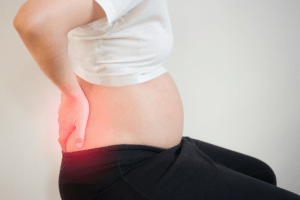
written by Pria Schwall-Kearney, FGHG Osteopath
Ouch! Pelvic Girdle Pain in pregnancy (PGP) is often referred to as ‘pelvic instability’ and affects somewhere between 20-50% of pregnancies. PGP causes mild to severe pain in the pelvis/low back that becomes worse with movement. It’s a significant source of pain and restriction for many pregnant women – but what actually is it?
The Pelvic girdle consists of seven bones – the triangular sacrum at the back (literally ‘sacred bone’ in latin, due to its role in childbirth) and three paired bones that make up the ‘hips’ – the ilia, ischia and pubic bones. Together these bones work together to take the weight of the spine, transfer and distribute forces evenly throughout the body whilst walking, and accommodate to allow the growth and passage of a baby throughout pregnancy and childbirth.
While it used to be thought that pelvic girdle pain was purely due to the hormonal effects of pregnancy, it is now understood to be a mix of the slight increase in movement available in these joints (due to the relaxed ligaments), and an increase in mechanical pressure on these joints.
Biomechanics in pregnancy are a topic on their own, but it is suffice to say that a woman’s posture changes early and rapidly when pregnant. The low back increases its arch, the pelvis widens, the ribs spread at the front and the legs step further apart to provide an increased base of support. It’s a well oiled machine – until it isn’t! Just like non-pregnant people, areas of increased muscular/ligamentous tension can develop, either due to stress, sedentary/computer posture, fatigue, or a slip or fall. However, in pregnancy the musculoskeletal system is working much closer to capacity and it can have difficulty compensating for these areas, which can lead to the pelvic girdle pain of pregnancy.
While the majority of cases of PGP go away after the baby is born, during pregnancy it can lead to significant pain and disability, with women having difficulty performing their daily activities. It can negatively impact fitness, flexibility and sleep, all of which have implications for childbirth and the postpartum period. So what can we do about it?
Strengthening exercises and use of supportive ‘sacroiliac belts’ have good reports. Osteopathic management of patients with PGP includes assessment of pelvic joints, bones, muscles and ligaments and uses a range of manual techniques to balance these tensions. We also look at the biomechanics of the surrounding areas, as well as giving advice on stretches, exercises and referrals to other providers as necessary.
Pelvic girdle pain is not something you can expect during pregnancy, however it is very common. If you think you might be experiencing this, take heart – there are things to be done. See a health professional about it and don’t just suffer through nine months of pain!
